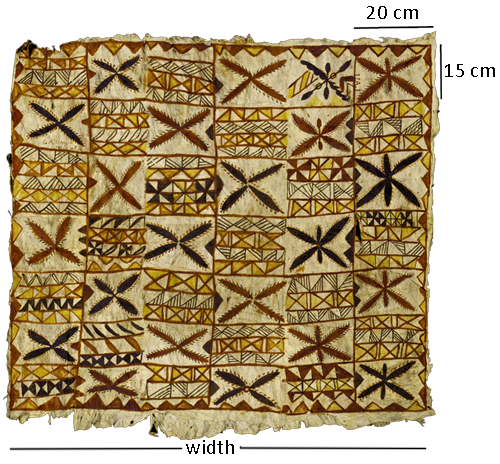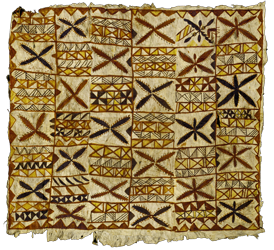Measuring tapa cloth
0
Overview
Using this Resource
Connecting to the Curriculum
Marking Student Responses
Working with Students
Further Resources
This task is about working out dimensions and area of a tapa cloth.
Elisaia is measuring his tapa cloth.
Each small section is about 20cm by 15cm.

Task administration:
This task can be completed with pencil and paper or online with auto-marking.
Copyright:
Level:
4
Curriculum info:
Description of task:
Student work out the side lengths and area of a tapa cloth from the measurement of a small section of it, converting between cm and metres.
Curriculum Links:
This resource can be used to help to identify students' understanding of area.
Learning Progression Frameworks
This resource can provide evidence of learning associated with within the Mathematics Learning Progressions Frameworks.
Read more about the Learning Progressions Frameworks.Answers/responses:
| Y8 (10/2014) | ||
| a) | B - 1.2 metres | very easy |
| b) | B - 1.05 metres | very easy |
| c) |
Both C and E ticked and no others ticked
C - "Go 20x15 and multiply it by the number of rectangles in the tapa cloth"
E - "Work out the height and width, and then multiply the two together"
Just 1 of C or E ticked and no others ticked
|
difficult
moderate
|
| d) | B - 1.26 metres | moderate |
Based on an online sample of 75 Year 8 students.
Diagnostic and formative information:
| Likely reason | Next steps | |
|
a) 1 metre
b) 1 metre
|
Students may estimate the side length rather than calculating it. | Encourage students to get more accuracy in their answer by using what measurements are available, e.g., 6 lots of 20cm (width) and 7 lots of 15 cm (height). |
| c) Just 1 of C or E ticked and no others ticked | Students tick just one of the correct strategies. | Students may be used to the idea of just one answer. Get them to revisit the problem and ask if there are any other answers that may be true as well. |
| c) Ticks one or more incorrect strategies. |
Students identify alternative incorrect strategies as correct.
|
Get students to justify each of the options they have ticked to each other in pairs, groups, or as a whole class. |
| d) D - 4.2 metres |
Students work out that there are 7 x 6 = 42 pieces so assumes each square is 0.1 square metres. [At or below curriculum level 3 (Year 6)]
|
See if students can work out the area of one small piece as 20 x 15 = 300 square cm. = 0.3 square metres. Then work out 42 lots of this size. They could also explore if there are other strategies that could be used to work out the area.
|
| d) C - 2.25 metres |
Students add 1.05 and 1.2 (area as the sum of two sides rather than the product). [At or below curriculum level 2 (Year 4-)]
|
Have students identify how many small pieces there are in the shape.
Students who need to work with simpler area problems could try working with unit squares, e.g., How many Xs cover Y, Area of four shapes, or Area of shapes II
|


